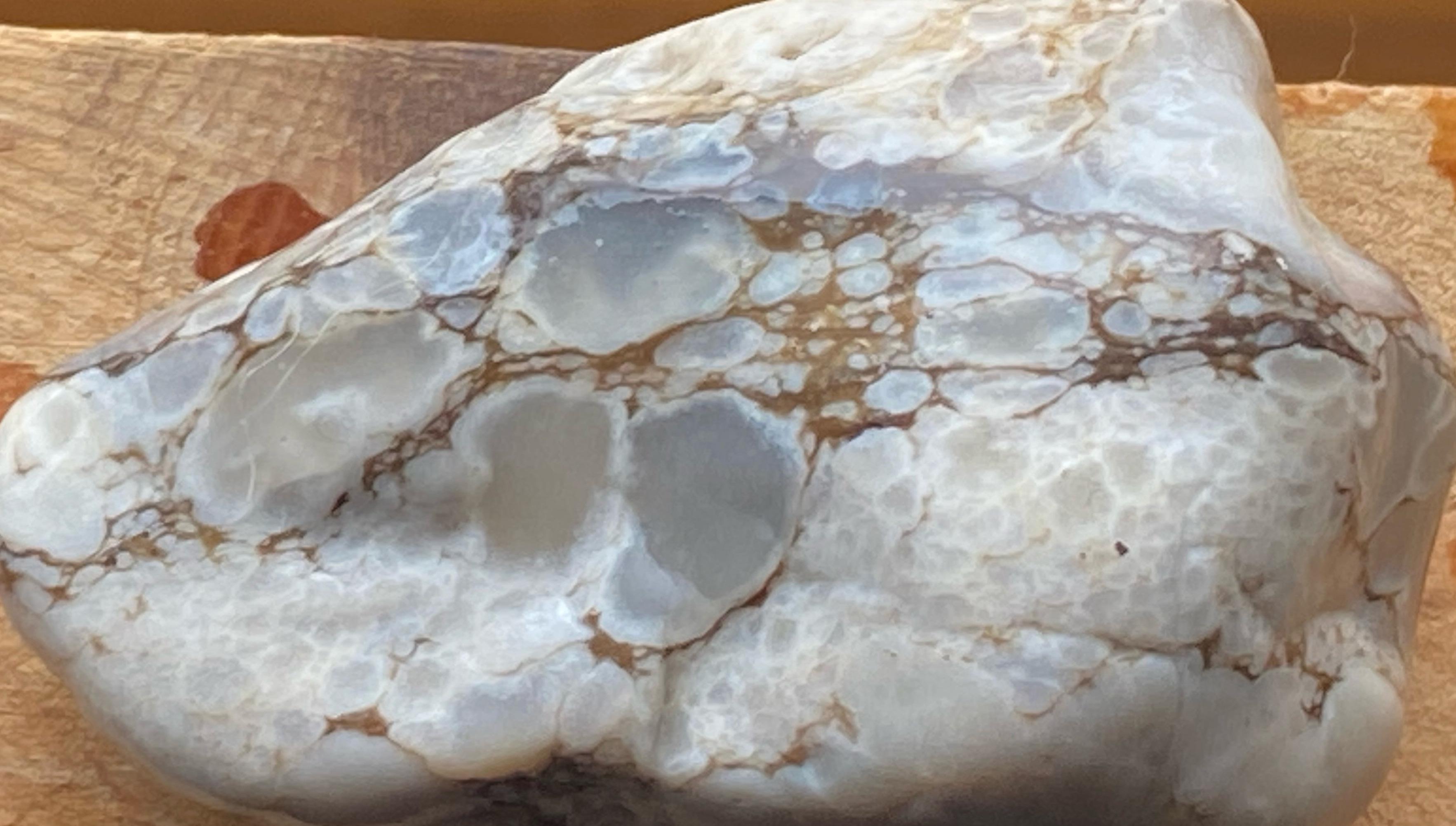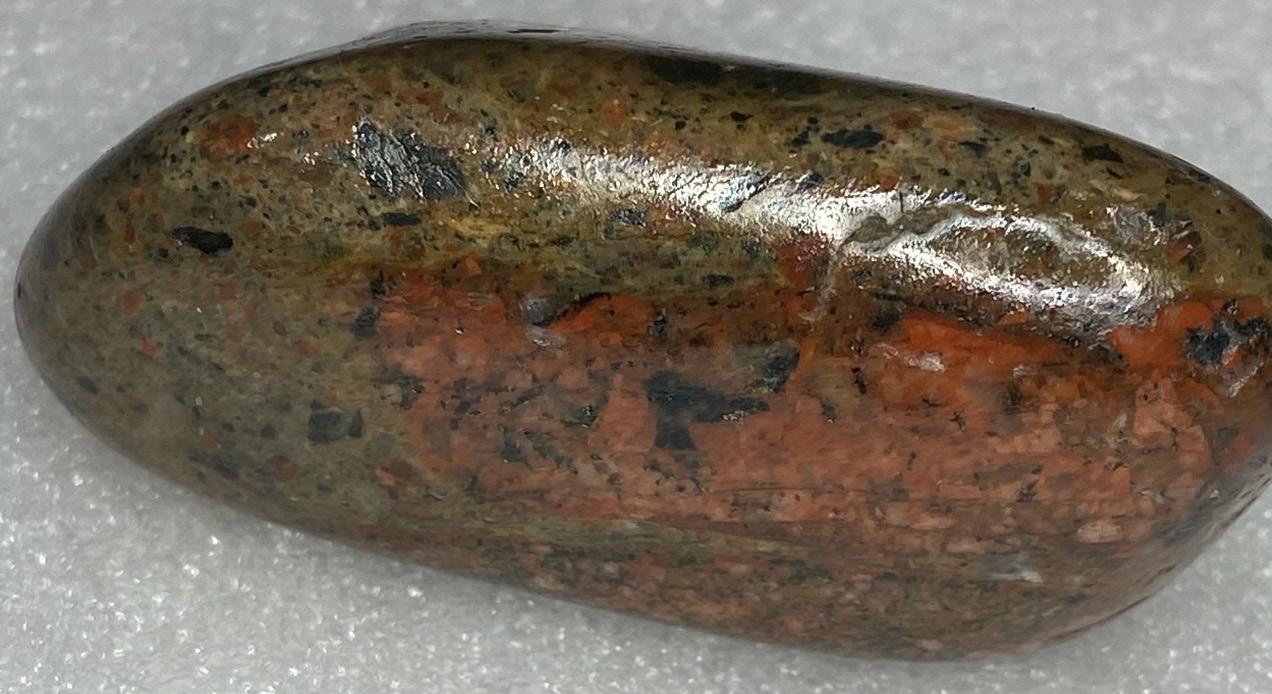
3 minute read
Your Rocks, Their Stories
by RockBound
By Craig McClarren Geologist
Michael Jeffries wrote
Advertisement
“
Ok, I have to post just a couple more from my recent trip of Lake Michigan from St Joseph to Leland. This one is one of my favorites! Those opaque looking pieces do have depth to them... I would ask if it’s an agate but I really don’t see banding. More like just a lot of little eyes into its soul.
#pleaseidentify”
So Michael, what you’ve got going on here is pretty complex and a lot of fun. What you’ve got is a limestone breccia. Now, this is different from most limestone breccias and let me explain how.
Limestone forms in shallow oceans and is easily dissolved by groundwater. Virtually all cave systems occur in limestone. Breccia is a rock composed of jagged smaller rocks, pieces of shattered material. Limestone breccias are places where caves have collapsed: sink holes and caverns caving in; that’s how most form, but not this one.
If you carefully observe the clasts in your rock, you’ll notice that each of them has an outer rind, which likely originally formed during this dessication process.


Those clasts are no longer the original limestone, however. This rock has undergone silicification, aka quartz replacement. Water, rich in dissolved quartz, worked its way through this rock and the calcite micro-minerals that made up the limestone were replaced by silica in the form of chalcedony and quartz. For those familiar with how cold water agates form, yes: this is the same process. This rock has none of the banding that would qualify it as an agate, but it has undergone the same process, giving the clasts that cloudy translucence.
So what you’ve got is a silicified limestone breccia caused by dessication during lithification with chalcedony and quartz replacement of clasts and ancient sand filling a few of the cracks between. And if you understood even a third of that sentence after reading this whole description… well, then I’ve done my job!
#pleaseidentify”
So this one is a bit complicated, but what a story this rock has to tell! Some parts of this rock appear to be fine-grained quartzite, which is what happens to sandstone when it undergoes a lot of heat and pressure over millions of years. But it’s certainly not just that, it contains large clasts (chunks) of granite and medium-sized subangular to subrounded (basically slightly to kind-of angular) clasts of a lithic material (lithic refers to dark-colored minerals). Here’s why that’s important: sandstones form in river or beach systems or sand dunes where the material has been worn down well. But that doesn’t jive with the other stuff going on: granite chunks don’t just appear randomly in sandstones usually; if the river wore all of the rocks down to sand grains, why would the big granite chunk be spared, right? It’s out of place. And what of those dark colored fragments? Lithic minerals (dark minerals) break down very quickly in river systems, dissolving away and turning to clay. And the sharper edges on those angular fragments should have been worn smooth like pebbles if not turned to sand.

So we know that the sand has probably traveled quite a bit to be desposited by a river, but that granite has not traveled far and those angular pieces of lithic material have been mechanically bashed apart and haven’t traveled far at all. So what the heck is going on here?

Well, a mix of rocks fragments like that in a single piece is how we define a conglomerate, or more accurately here, a metaconglomerate (a conglomerate that has undergone metamorphism [ie, look to the quartzite]). Our most famous metaconglomerates in Michigan are our beautiful puddingstones and Gowganda tillites (neither of which actually originate in Michigan, but were left here by the glaciers after being torn out of the ground in Canada).
Now, this is neither a puddingstone nor a gowganda tillite from what I can see, but it’s certainly an interesting mix of different environmental features. The quartzite suggests a river deposition while the lithic and granite clasts strongly suggest a tillite (a rock made of fragments deposited by a glacier).
Really, the only way this rock could have formed is from a river near the edge of a glacier where sand was deposited during regular flow periods and where periodic floods from glacial bursts transported fragments of glacial debris. So we can look at this rock and see just where it formed: in a warming environment at the end of an ice age on a sandy and slightly pebbly river near the edge of a melting glacier where major floods could sweep through at any time!










